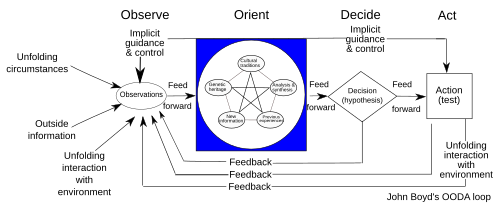OODA loop

The OODA loop (observe, orient, decide, act) is a decision-making model developed by United States Air Force Colonel John Boyd. He applied the concept to the combat operations process, often at the operational level during military campaigns. It is often applied to understand commercial operations and learning processes. The approach explains how agility can overcome raw power in dealing with human opponents.
The OODA loop
[edit]As can be seen from the diagram, the OODA loop includes continuous collection of feedback and observations. This enables late commitment, which is an important element of agility. This is in contrast to the PDCA cycle which requires early commitment (the first steps are Plan and Do).
Use in law and business
[edit]The OODA loop has become an important concept in litigation,[1] business,[2] law enforcement,[3] management education,[4][5] military strategy and cyber security, and cyberwarfare.[6] According to Boyd, decision-making occurs in an iterative cycle of "observe, orient, decide, act". An entity (whether an individual or an organization) that can process this cycle quickly, observing and reacting to unfolding events more rapidly and/or more effectively than an opponent, can thereby get inside the opponent's decision cycle and gain the advantage.
Jamie Dimon, chairman and CEO of JPMorgan Chase, has said he uses the OODA loop in scenario evaluation.[7][8][9]
Criticism
[edit]Some scholars are critical of the concept. Aviation historian Michael Hankins, for example, writes that "the OODA loop is vague enough that its defenders and attackers can each see what they want to see in it. For some, the OODA concept’s flexibility is its strength, but for others it becomes so generalized as to lose its usefulness." He concludes that "The OODA loop is merely one way among a myriad of ways of describing intuitive processes of learning and decision making that most people experience daily. It is not incorrect, but neither is it unique or especially profound."[10]
See also
[edit]References
[edit]- ^ Dreier pp. 20–85.
- ^ Richards pp. 162–171.
- ^ Papenfuhs, Steve (Pappy). "The OODA loop, reaction time, and decision making". PoliceOne.com. Retrieved 3 November 2016.
- ^ Ryder, Mike; Downs, Carolyn (November 2022). "Rethinking reflective practice: John Boyd's OODA loop as an alternative to Kolb". The International Journal of Management Education. 20 (3): 100703. doi:10.1016/j.ijme.2022.100703.
- ^ Ryder, Mike (2024). "Using OODA Loops to Build Sustainable Practice into Business Education". In Wall, Tony; Trevisan, Laís Viera; Filho, Walter Leal; Shore, Adam (eds.). Sustainability in Business Education, Research and Practices. World Sustainability Series. Springer. pp. 77–89. doi:10.1007/978-3-031-55996-9_6. ISBN 978-3-031-55995-2.
- ^ Clarke, Richard (2019). The Fifth Domain:Defending Our Country, Our Companies, and Ourselves in the Age of Cyber Threats. Penguin Press. p. 81. ISBN 978-0525561965.
- ^ Pringle, Eleanor. "Jamie Dimon says he runs JPMorgan with a military tactic in mind named the 'OODA loop'". Fortune.
- ^ Pringle, Eleanor. "Jamie Dimon says World War III may have already begun". Fortune.
- ^ "Jamie Dimon's Letter to Shareholder's, Annual Report 2023 | JPMorganChase". www.jpmorganchase.com.
- ^ Michael W. Hankins, Flying Camelot: The F-15, the F-16, and the Weaponization of Fighter Pilot Nostalgia (Cornell University Press, 2021), 134-135.
Bibliography
[edit]- Boyd, John R. (3 September 1976). Destruction and Creation (PDF). U.S. Army Command and General Staff College.
- Boyd, John, R., The Essence of Winning and Losing, 28 June 1995 a five slide set by Boyd.
- Dreier, A.S. (2012). Strategy, Planning & Litigating to Win. Boston, MA: Conatus Press. ISBN 978-0615676951. OCLC 917563752.
- Greene, Robert, OODA and You
- Hillaker, Harry, Code one magazine, "John Boyd, United States Air Force Retired, Father of the F16", July 1997.
- Linger, Henry, Constructing The Infrastructure for the Knowledge Economy: Methods and Tools, Theory and Practice, p. 449
- Metayer, Estelle, Decision making: It's all about taking off – and landing safely…, Competia, December 2011
- Osinga, Frans, "Science, Strategy and War The Strategic Theory of John Boyd"
- Richards, Chet, Certain to Win: the Strategy of John Boyd, Applied to Business (2004) ISBN 1413453775
- Ullman, David G., [1]"OO–OO–OO!” The Sound of a Broken OODA Loop], Crosstalk, April 2007
External links
[edit]- Archived documents
- Video: The OODA Loop and Clausewitzian "Friction"
- Bazin, A. (2005). "Boyd's OODA Loop and the Infantry Company Commander". Infantry Magazine.
- OODA Loop 2.0: Information, Not Agility, Is Life OODA Loop 2.0: Information, Not Agility, Is Life
- OODA Loop in Emergency Preparedness OODA Loop in Emergency Preparedness
